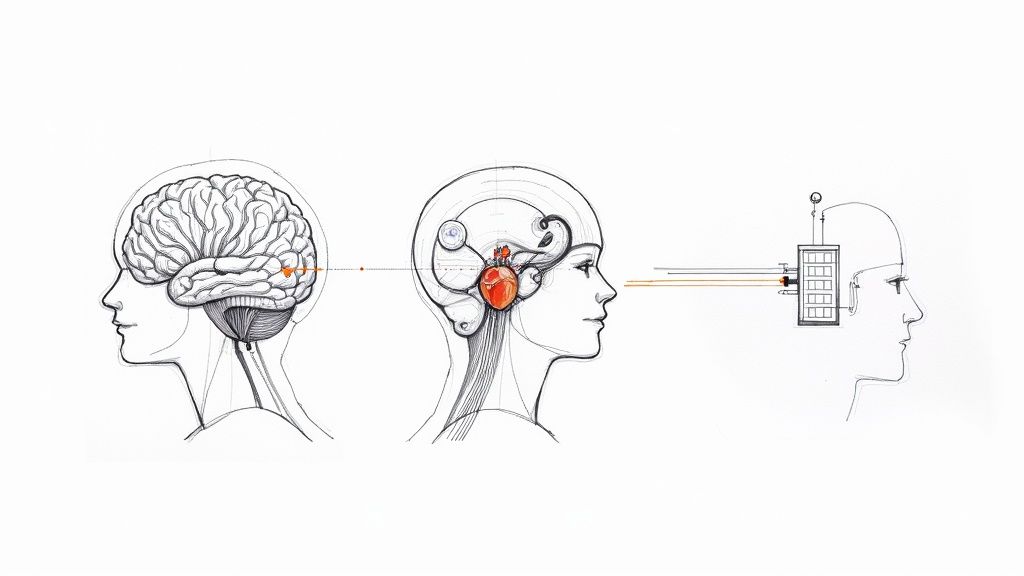12 Top Healthcare AI Companies to Watch in 2025
Discover the top 12 healthcare AI companies transforming patient care. Our 2025 guide covers platforms for imaging, documentation, and operations.
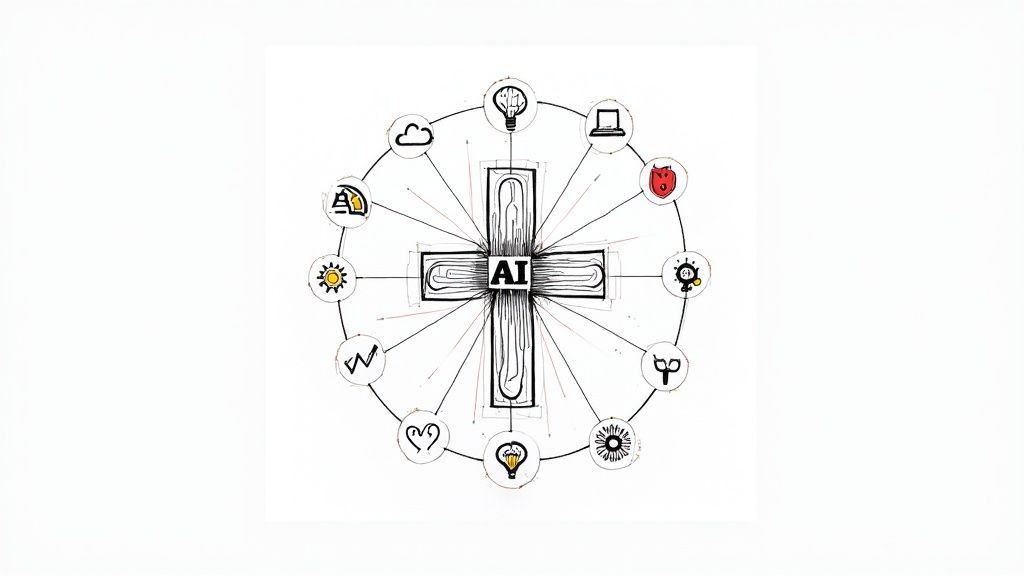
Artificial intelligence is no longer a futuristic concept in medicine; it's a present-day reality revolutionizing diagnostics, treatment, and operations. For healthcare leaders, the challenge isn't whether to adopt AI, but how to navigate the crowded marketplace of solutions. This guide cuts through the noise, offering a curated look at 12 leading healthcare AI companies and platforms. We'll move beyond marketing claims to analyze real-world applications, implementation hurdles, and the strategic value each partner brings, helping you identify the right technology to solve your most pressing clinical and operational challenges.
This article is designed as a practical resource for decision-makers. Instead of generic descriptions, you will find a detailed breakdown of what each company truly offers. We provide an honest assessment of their core services, from AI-powered medical imaging analysis to clinical documentation and operational workflow automation. To understand the broader competitive landscape and identify key players, explore insights on leading healthcare AI companies.
Our goal is to equip you with the information needed to make an informed decision. For each company and platform, we will explore:
- Core Services & Specialization: What specific problem do they solve?
- Key Features & Technology: A look at their flagship products and the AI driving them.
- Practical Use Cases: Real-world examples of how their technology is being used today.
- Implementation Considerations: What to expect when integrating their solutions into your existing systems.
Each entry includes screenshots for a visual reference and direct links to explore the platforms further. By the end of this guide, you will have a clear understanding of the major players and be better prepared to select a partner that aligns with your organization's strategic goals.
1. Aidoc
Aidoc stands out among healthcare AI companies by offering an enterprise-grade platform, aiOS, designed to orchestrate and scale clinical imaging AI solutions across large health systems. Instead of deploying individual point solutions, Aidoc provides a unified operating system that integrates multiple AI algorithms, including its own FDA-cleared suite and third-party tools. This approach tackles the significant challenge of "AI sprawl," where hospitals struggle to manage dozens of disconnected AI applications.
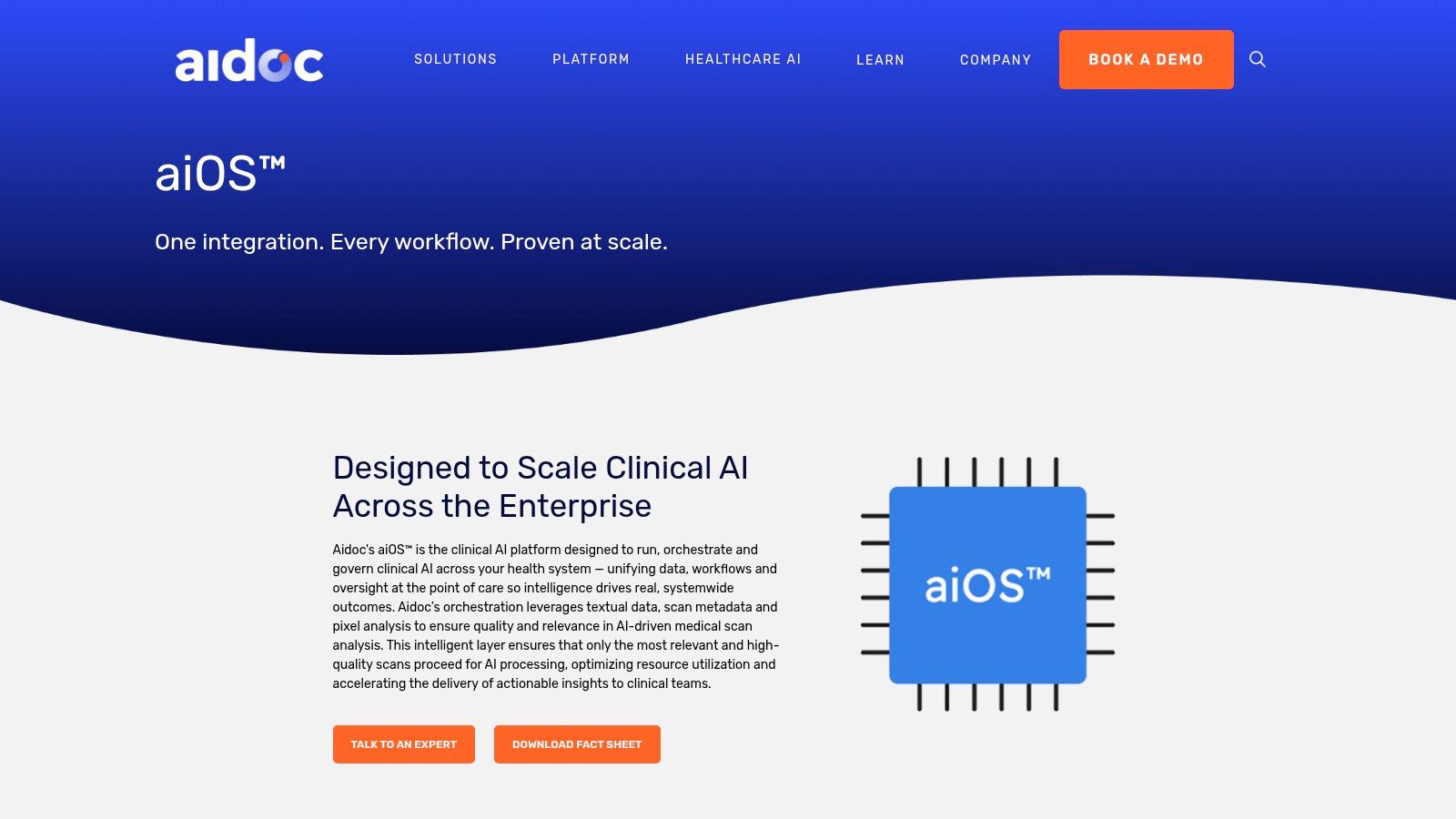
The platform's strength lies in its deep workflow integration. By embedding directly into existing Picture Archiving and Communication Systems (PACS), Electronic Health Records (EHR), and mobile triage alerts, it ensures radiologists and clinicians can access AI insights without disrupting their established routines. This seamless user experience is critical for driving adoption and realizing the technology's full potential.
Key Features and Use Cases
Aidoc's aiOS is built for scale and governance, making it a strategic choice for organizations moving beyond pilot projects.
- AI Orchestration: The platform intelligently runs the most relevant algorithm for a given scan, even identifying multiple potential findings from a single image. A real-world use case involves a single head CT scan being analyzed simultaneously for both intracranial hemorrhage and C-spine fractures, prioritizing the most critical findings for the radiologist.
- Comprehensive Governance: Features like performance analytics, drift detection, and override tracking provide the necessary oversight to manage AI responsibly at an enterprise level. This helps administrators ensure a strong return on investment and maintain clinical quality.
- Workflow Integration: Direct integration with tools like Nuance PowerScribe and mobile communication platforms accelerates the time from detection to treatment, a crucial factor in emergent conditions like stroke or pulmonary embolism. For deeper insights into similar diagnostic AI tools, you can explore more about AI-driven diagnostics on ekipa.ai.
Pricing and Implementation
Pricing is quote-based and tailored to the number of sites and the size of the AI algorithm portfolio. While this model requires a direct consultation, it allows for a customized package. The platform delivers the most significant value to larger, multi-site health systems with high imaging volumes, where the benefits of centralized governance and scaled deployment are most pronounced.
2. Viz.ai
Viz.ai is a standout among healthcare AI companies for its focus on synchronizing care and accelerating treatment for time-sensitive conditions. Its AI-powered care coordination platform, Viz One, uses over 50 FDA-cleared algorithms to automatically detect suspected diseases from various imaging sources like CT, echo, and EKG. The platform’s core strength is its ability to instantly alert on-call care teams, enabling real-time collaboration and drastically shortening the time from diagnosis to intervention.
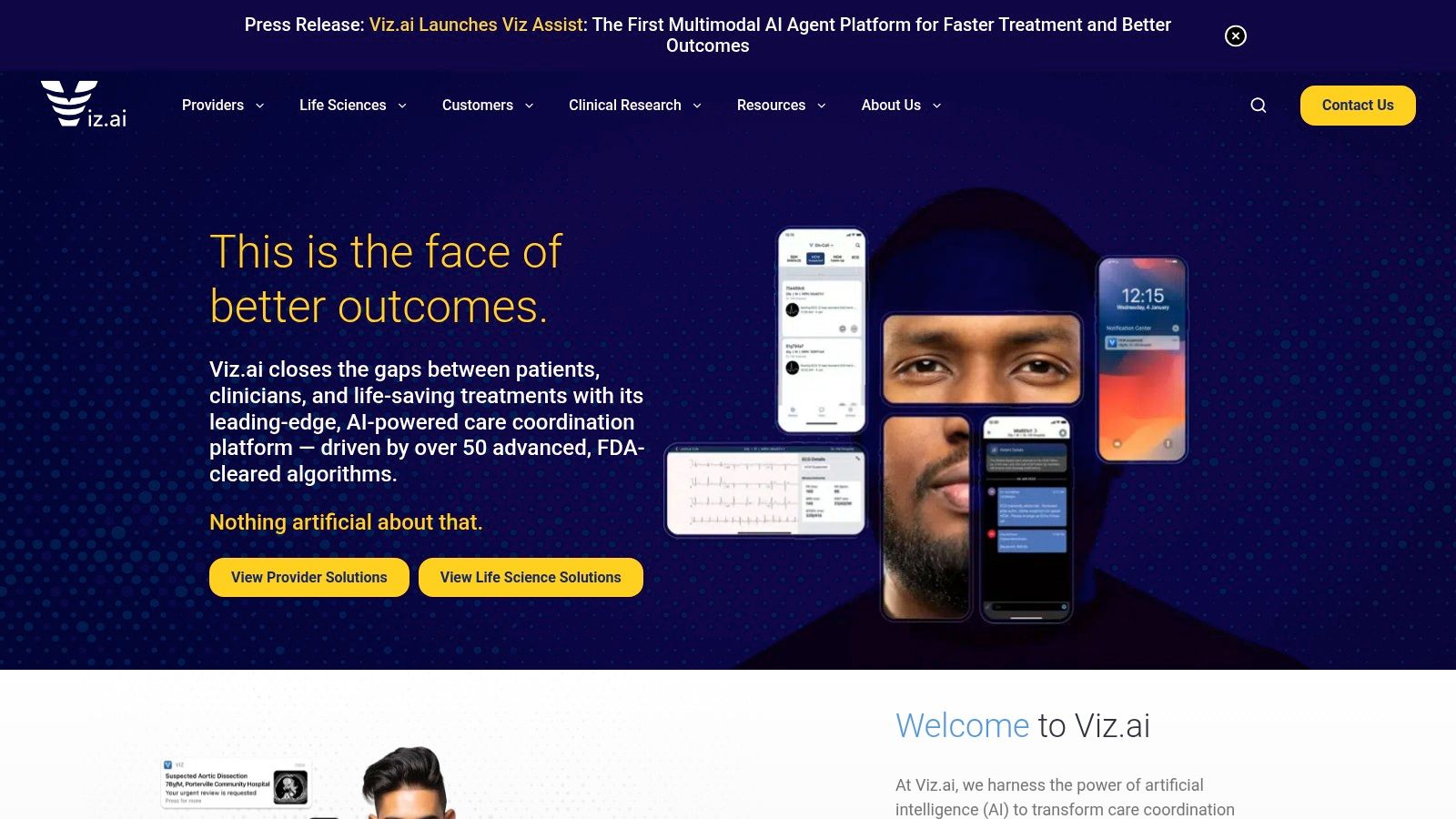
This focus on care coordination sets Viz.ai apart. Rather than just flagging an issue for a radiologist, it connects the entire response team-from specialists to surgeons-on a secure, HIPAA-compliant mobile and desktop platform. This immediate, shared context allows for faster clinical decision-making, which is critical in emergencies like stroke or aortic dissection, where every second counts. Its strong mobile-first design ensures on-call specialists have actionable insights at their fingertips.
Key Features and Use Cases
Viz.ai’s platform is designed as a series of modular therapeutic suites, allowing health systems to target specific clinical pathways where speed is paramount.
- Automated Disease Detection: The platform ingests imaging data directly from the scanner and runs relevant algorithms automatically. A prime use case is in stroke care, where the Viz LVO module detects suspected large vessel occlusions on CT angiograms and alerts the entire stroke team, often before the patient has even left the scanner.
- Intelligent Care Coordination: Configurable alerts and secure team messaging are built directly into the workflow. This allows neurologists, interventionalists, and emergency physicians to view images, communicate, and align on a treatment plan within minutes, directly from their phones.
- Modular Therapeutic Suites: Hospitals can implement specific modules for Neuro, Cardio, Vascular, and Trauma. This modularity allows organizations to address their most pressing clinical needs first, such as improving door-to-needle times for pulmonary embolism or coordinating trauma transfers.
Pricing and Implementation
Viz.ai uses a quote-based pricing model, with costs depending on the modules selected and the size of the health system. Implementation requires deep integration with existing imaging (PACS) and EHR systems to achieve full functionality. The platform offers the highest ROI in settings with significant volume in acute conditions, where improved care coordination can directly lead to better patient outcomes and optimized resource utilization.
3. Abridge
Abridge tackles one of the most significant sources of clinician burnout: documentation. The platform uses generative AI to listen to patient-clinician conversations and automatically draft structured clinical notes in real-time. By integrating deeply into Electronic Health Record (EHR) systems like Epic, Abridge aims to give providers back valuable time, allowing them to focus more on patient care and less on administrative tasks. Its ability to generate notes tuned for over 100 specialties makes it a versatile solution for large, diverse health systems.
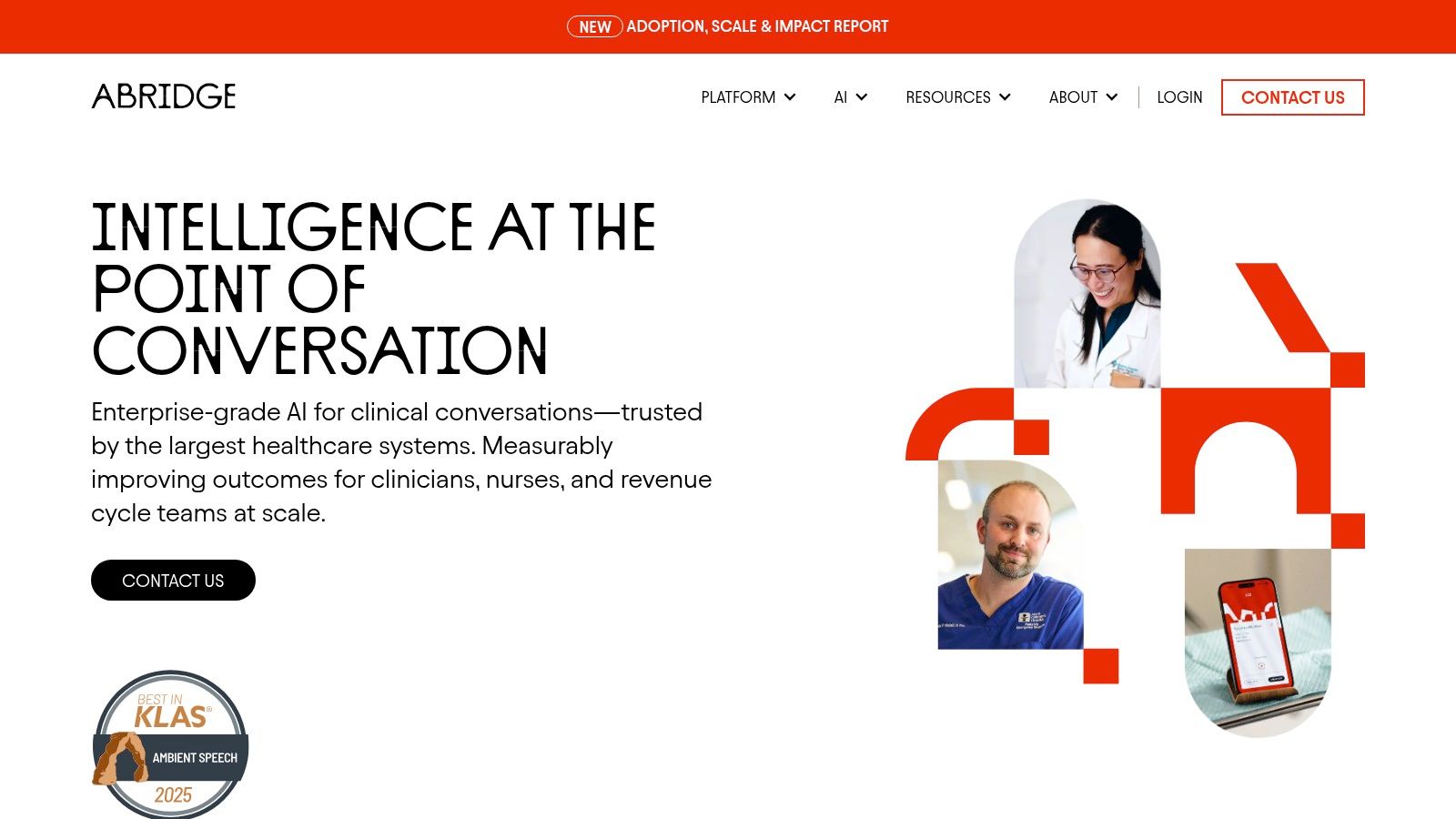
The core value of Abridge lies in its seamless workflow integration and high-quality, specialty-specific output. The platform's participation in programs like Epic's Partners and Pals allows it to embed directly within the clinician's existing environment, minimizing disruption and accelerating adoption. This focus on workflow harmony is a key reason it stands out among other healthcare AI companies in the clinical documentation space.
Key Features and Use Cases
Abridge is designed for rapid enterprise deployment, with a strong focus on immediate value and clinician satisfaction.
- Real-Time Note Generation: The AI actively listens and structures notes during the patient encounter, creating an initial draft that clinicians can quickly review and finalize. This is particularly impactful in high-volume settings like emergency medicine, where documentation speed is critical.
- Deep EHR Integration: Through official partnerships, Abridge places its AI-generated notes directly into the correct fields within the EHR. A clinician finishing an appointment can find a nearly complete, structured note ready for their sign-off, saving significant time. For a deeper understanding of tools that streamline clinical workflows, you can find more about AI clinical assistants on ekipa.ai.
- Specialty-Specific Models: The AI is tuned for over 100 specialties, from cardiology to primary care, ensuring the generated notes use appropriate terminology and follow expected formats. This customization improves the quality and relevance of the documentation.
Pricing and Implementation
Abridge's pricing is quote-based and designed for enterprise-level contracts with health systems. It is not available for individual clinician purchase. The model is built for scale, making it best suited for organizations looking to deploy an ambient documentation solution across multiple departments or facilities. While the potential for competing tools from EHR vendors exists, Abridge's rapid rollouts and positive clinician feedback position it as a strong current leader.
4. Nuance Dragon Medical One (Microsoft)
Nuance Dragon Medical One, now part of Microsoft, is a cornerstone among healthcare AI companies, delivering a highly refined, cloud-based speech recognition platform that transforms clinical documentation. It stands apart by offering a direct, transparent e-commerce model for smaller practices in the U.S., allowing them to purchase licenses online without lengthy sales cycles. This accessibility, combined with its mature and widely trusted speech engine, makes it a go-to solution for physicians looking to reduce administrative burdens and focus on patient care.
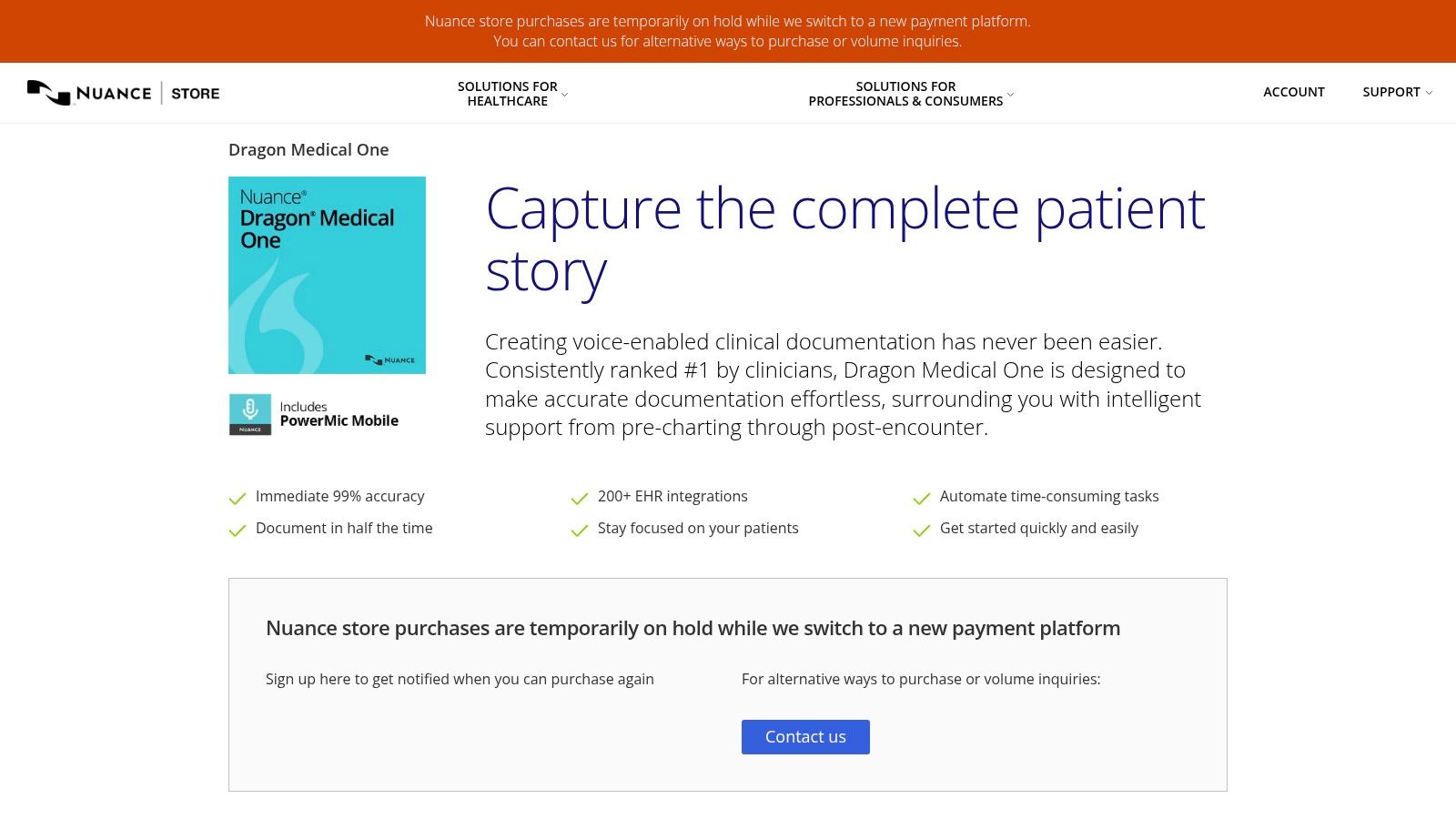
The platform is engineered for deep integration into clinical workflows, working seamlessly within most major EHR systems. By allowing clinicians to dictate notes directly into patient records using their voice, it drastically cuts down on manual typing and streamlines the documentation process. The inclusion of the PowerMic Mobile app further enhances flexibility, turning any smartphone into a secure wireless microphone for dictation on the go.
Key Features and Use Cases
Dragon Medical One excels at providing a reliable and efficient user experience, backed by the strategic resources of Microsoft.
- Cloud-Based Speech Recognition: The core technology provides exceptional accuracy for medical terminology across over 90 specialties. A common use case involves a physician dictating a complex patient encounter note directly into an EHR template, with the AI correctly transcribing specialized terms and formatting the text in real-time.
- EHR and Workflow Compatibility: The platform is designed to operate as a lightweight client that integrates with existing systems, rather than replacing them. This ensures clinicians can continue using their familiar EHR interfaces while leveraging powerful voice-to-text capabilities.
- Accessible Subscription Model: For U.S.-based practices, the ability to purchase small license bundles directly online with transparent pricing is a significant advantage. This simplifies adoption for private practices and smaller clinics that may not have enterprise-level procurement teams. Explore how similar AI tools can optimize workflows with this guide to HCP engagement solutions from ekipa.ai.
Pricing and Implementation
Nuance offers a transparent per-user subscription model, priced at $99 per user/month with a one-year commitment, available for online purchase in the U.S. A one-time mandatory setup service fee is required for first-time users to ensure proper configuration. While the desktop client is Windows-only, the platform's reliability and integration with Microsoft's broader healthcare AI vision make it a strategic choice for practices seeking to improve documentation efficiency and physician satisfaction.
5. Epic Showroom (Open Epic / Connection Hub)
While not a standalone AI vendor, the Epic Showroom (formerly Connection Hub) is a critical resource for any health system operating on the Epic EHR platform. It functions as a curated marketplace, allowing organizations to discover and validate third-party AI applications designed to integrate directly into Epic workflows. This solves a major implementation hurdle by providing a centralized catalog of tools that have established integration pathways, significantly streamlining the security and technical review process for healthcare AI companies.
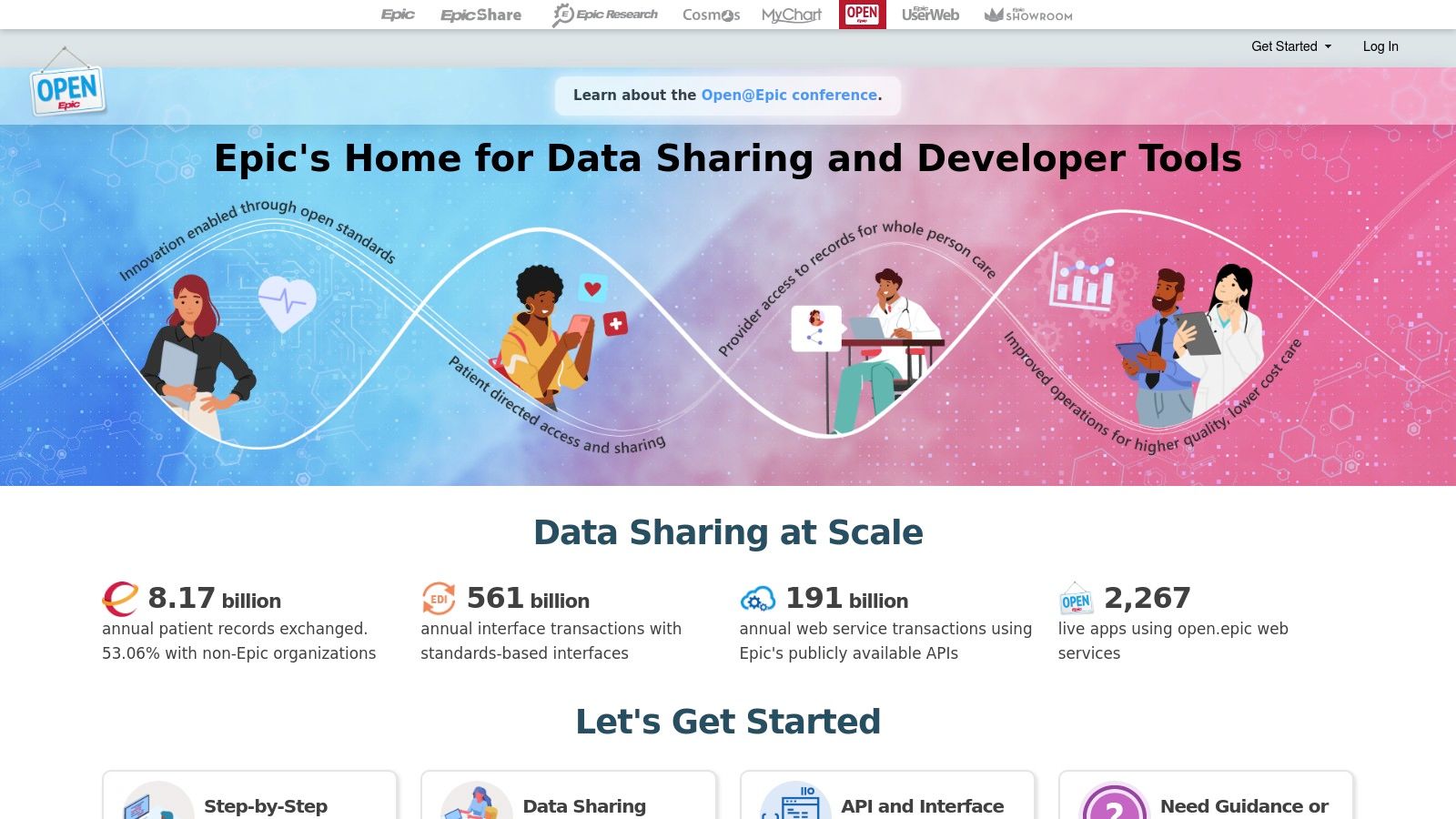
The platform’s value is its focus on interoperability. By detailing how each solution connects via APIs like FHIR or through specific Epic programs, it gives IT and clinical leaders confidence that a new tool will complement, not disrupt, their existing ecosystem. This makes it an essential first stop for Epic-based health systems exploring AI solutions for documentation, imaging, patient engagement, or operations.
Key Features and Use Cases
The Epic Showroom is designed to de-risk the AI procurement and integration process for the world's largest EHR user base.
- Vetted Vendor Marketplace: Health systems can browse hundreds of vendor listings, from ambient clinical documentation tools to predictive analytics platforms, with clear information on their integration status. A practical use case involves a clinical informatics team filtering for AI scribes that use Epic's "Toolbox" for seamless note entry, comparing options, and initiating contact directly.
- Integration Transparency: The platform details the specific technical connection points for each application. This allows technical teams to quickly assess the feasibility and security implications of integrating a new AI tool before committing significant resources.
- Workflow-Centric Discovery: Unlike generic lists, the Showroom allows users to find solutions tailored to specific Epic modules and clinical workflows. For example, a radiology department can identify imaging AI vendors certified to deliver results directly into the radiologist's reading worklist.
Pricing and Implementation
Access to the Epic Showroom is generally available, but the procurement and implementation of the listed applications are limited to existing Epic customers. Pricing is determined by the individual third-party vendors and is almost always quote-based, requiring direct engagement. The primary advantage is for health systems already invested in the Epic ecosystem, as it dramatically reduces the friction and uncertainty of adopting new AI technologies by pre-vetting their integration capabilities.
6. AWS Marketplace – Healthcare AI solutions
AWS Marketplace provides a centralized platform for healthcare organizations to discover, procure, and deploy third-party AI and machine learning solutions. Rather than contracting with dozens of individual vendors, it allows enterprises to leverage their existing AWS relationship for streamlined billing, licensing, and governance. This model transforms the complex process of sourcing healthcare AI companies into a managed, cloud-native experience, significantly reducing procurement friction and accelerating innovation.
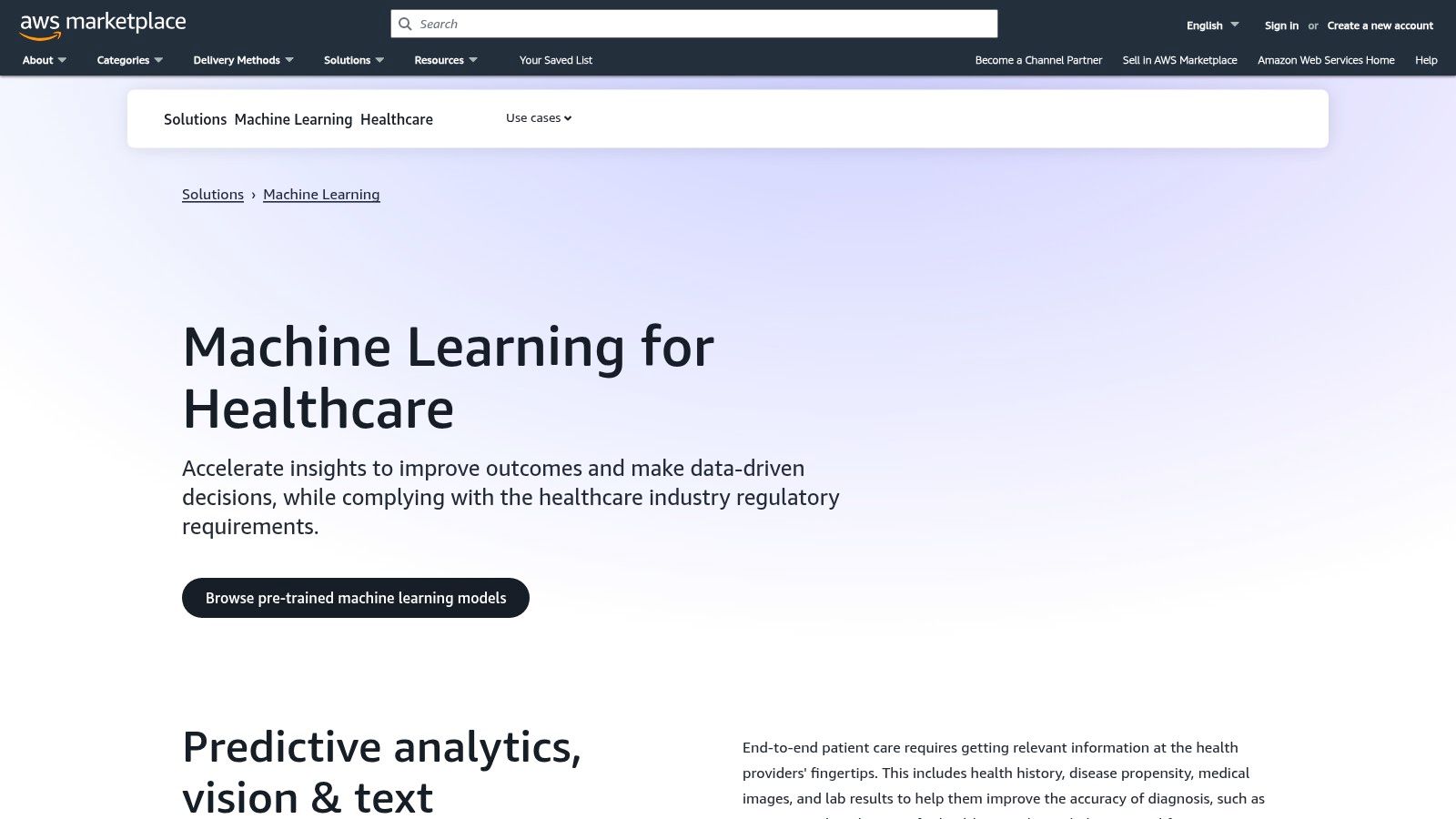
The platform’s key advantage is its integration with the broader AWS ecosystem. Solutions deployed through the marketplace can seamlessly connect with secure data storage, compute resources, and security controls already in place. This simplifies the technical and compliance overhead associated with implementing new AI tools, allowing organizations to focus on clinical and operational value instead of infrastructure management.
Key Features and Use Cases
The marketplace is designed to fit enterprise procurement workflows while offering the flexibility of a modern software catalog.
- Centralized Procurement: It serves as a single source for a wide range of solutions, from medical imaging analysis to clinical trial management. A health system can use the marketplace to test a new diagnostic algorithm via a free trial and then convert it to a full subscription, all under a consolidated AWS bill.
- Flexible Commercial Terms: The platform supports various models, including SaaS subscriptions, pay-as-you-go, and private offers with custom terms. This enables organizations to align AI spending with usage and draw down on existing AWS enterprise discount commitments.
- Integrated Governance: Deployments are managed within an organization’s existing AWS account, ensuring all new software adheres to established security policies, identity management, and cost controls. This is critical for maintaining compliance in a highly regulated industry.
Pricing and Implementation
Pricing varies widely by vendor and solution, with options for free trials, hourly rates, and annual contracts. Implementation requires an active AWS account and a degree of cloud competency, as organizations are responsible for deploying and managing the solutions within their own environment. While many listings are self-service, some regulated or complex solutions may necessitate direct engagement with the vendor for setup and validation. The platform is best suited for organizations already invested in the AWS ecosystem.
7. Google Cloud Marketplace – Healthcare and Life Sciences
The Google Cloud Marketplace offers a strategic advantage for organizations already invested in the Google ecosystem, functioning less as a single AI vendor and more as a curated discovery and deployment engine for leading healthcare AI companies. It centralizes the procurement and management of third-party SaaS, AI models, and specialized services through a single, unified interface. This approach directly addresses the challenge of vendor fragmentation by allowing health systems to find, purchase, and deploy pre-vetted AI solutions using their existing Google Cloud commitment.
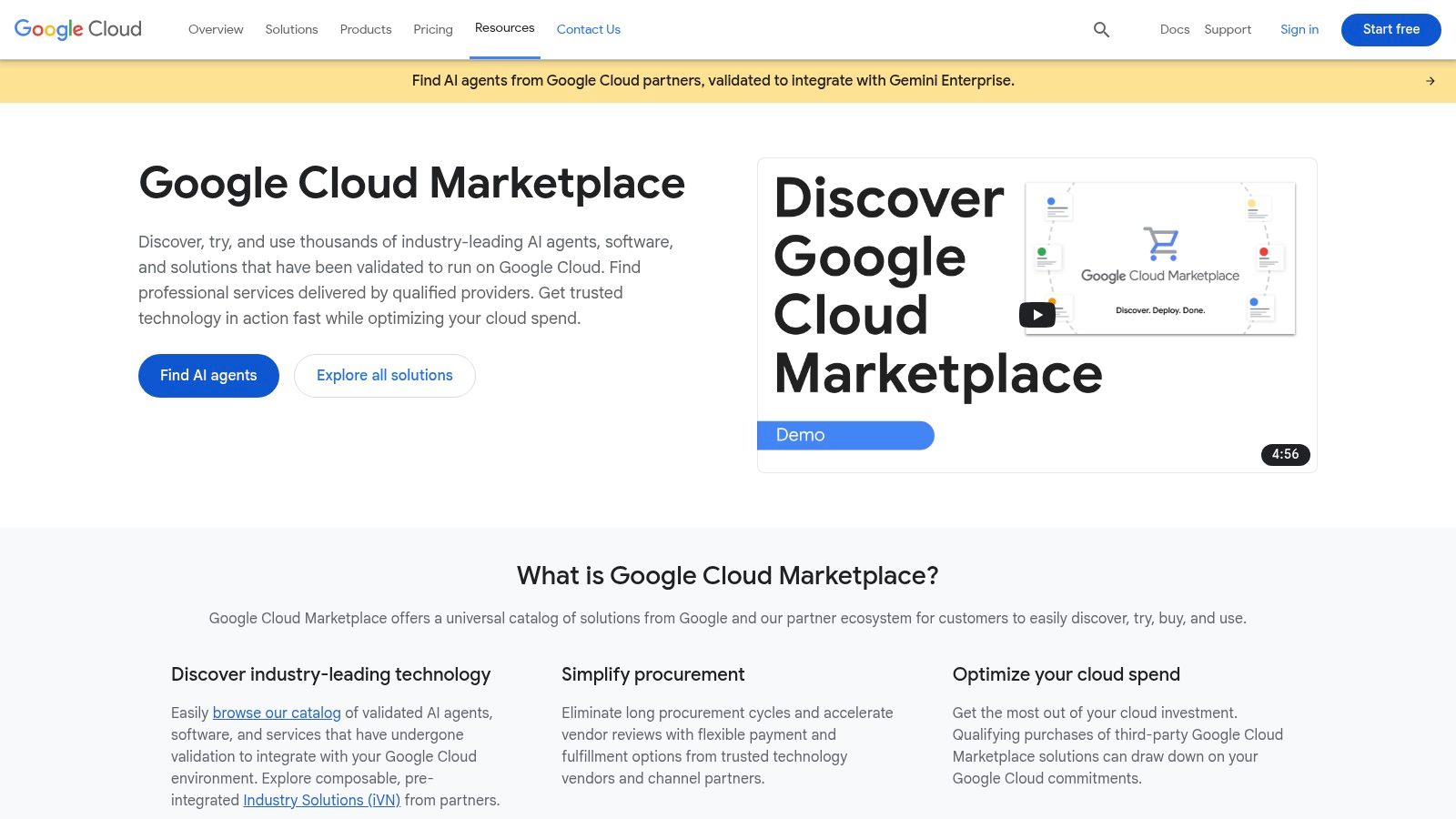
This platform stands out by integrating governance and billing directly into the cloud console that IT teams already use. Instead of managing separate contracts and security reviews for each AI tool, organizations can leverage Google's infrastructure for consolidated oversight. The dedicated Healthcare and Life Sciences section further simplifies discovery, highlighting solutions built for clinical and operational challenges.
Key Features and Use Cases
The Marketplace is designed for streamlined governance and scalability, making it ideal for enterprises with established cloud operations.
- Integrated Governance and Billing: Organizations can use their existing Google Cloud committed spend to purchase third-party AI solutions, simplifying budget allocation. All activity is tracked within the Google Cloud Console, providing a single source of truth for cost reporting, access controls, and security.
- Validated Partner Solutions: Every offering in the marketplace is validated to run on Google Cloud, reducing the technical risk of adoption. A use case involves a hospital's data science team quickly deploying a validated third-party de-identification API from the marketplace to prepare a research dataset, bypassing a lengthy internal development cycle.
- Private Marketplace Curation: Enterprises can create a "private marketplace," a pre-approved catalog of AI solutions for their internal teams. This empowers departments to adopt new technologies quickly while ensuring they comply with enterprise-wide security and procurement policies.
Pricing and Implementation
Pricing for solutions is set by the individual third-party vendors, but billing is consolidated through the customer's Google Cloud account. Access requires an existing Google Cloud tenancy, making it a natural fit for current Google Cloud Platform (GCP) customers. While the marketplace streamlines discovery, some complex enterprise healthcare AI tools may still require a direct onboarding process with the vendor. The platform's value is maximized for organizations seeking to centralize AI procurement and governance within their cloud strategy.
8. Microsoft Azure / Microsoft Marketplace – Healthcare AI
Microsoft Azure Marketplace serves as a centralized hub for discovering and deploying third-party healthcare AI solutions, making it a strategic asset for health systems already invested in the Microsoft ecosystem. Rather than being a single product, it is a vast catalog of vetted applications covering everything from ambient clinical documentation to automated prior authorization and clinical natural language processing (CNLP). This platform streamlines the often-complex procurement and deployment process for new AI tools.
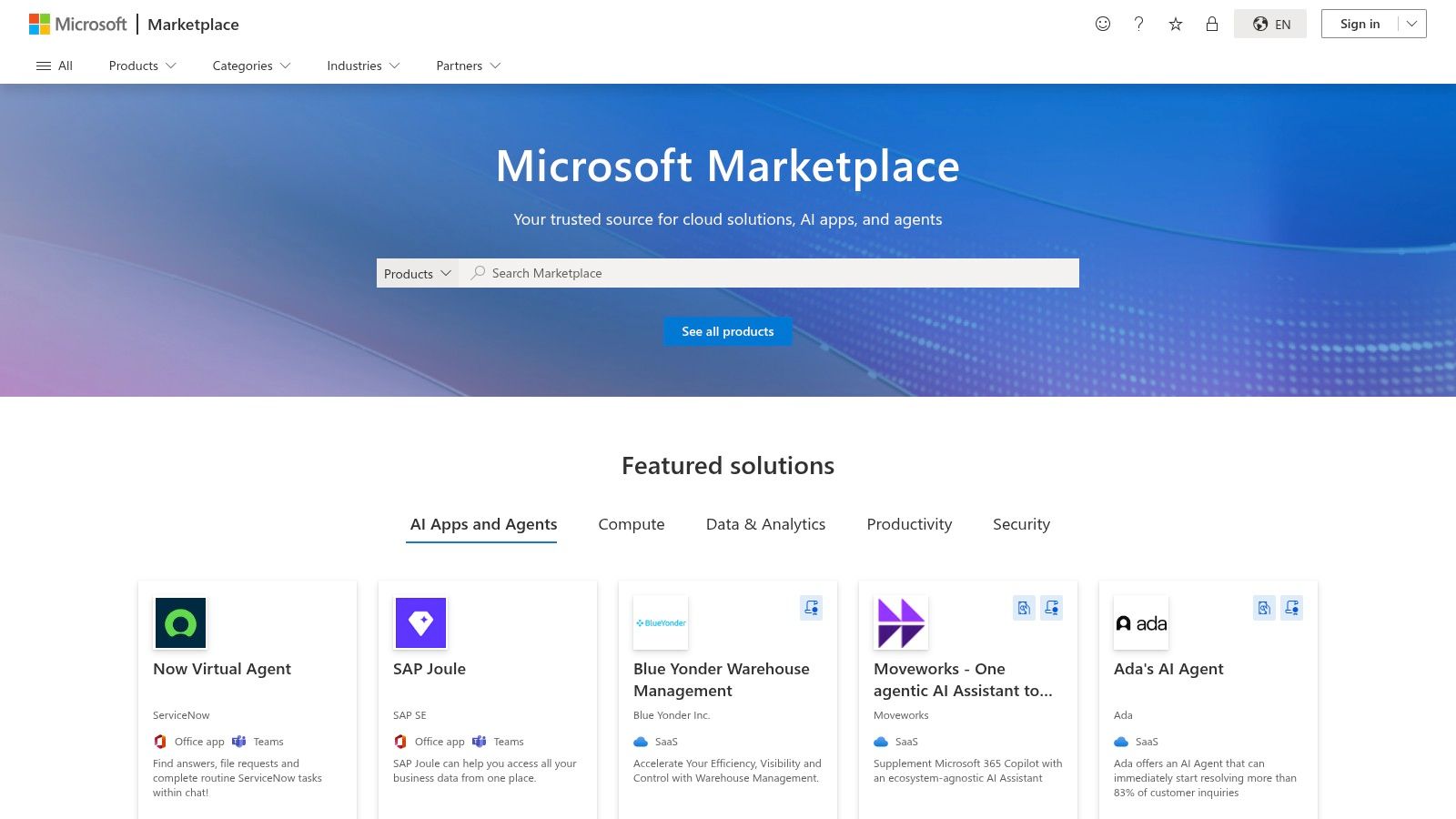
The primary advantage is its deep integration with Azure’s cloud infrastructure. Healthcare organizations can leverage existing Microsoft enterprise agreements and Azure credits to acquire and manage AI solutions. This approach simplifies billing, enhances security through unified identity management, and ensures that new applications align with established compliance frameworks like HIPAA.
Key Features and Use Cases
The Marketplace excels at simplifying access to innovative technologies for established enterprise IT environments.
- Integrated Procurement: Health systems can purchase and deploy AI applications using their existing Azure accounts and billing arrangements. A practical use case involves a hospital using its committed Azure spend to trial a new CNLP tool for analyzing unstructured EHR notes without a lengthy, separate vendor onboarding process.
- Azure Deployment Tooling: Many listings come with pre-configured deployment templates that streamline the technical setup within an organization's secure Azure environment. This accelerates the path from purchase to production, reducing the burden on internal IT teams.
- Vetted and Secure Solutions: Microsoft reviews applications for security and best practices, providing a layer of assurance. This is particularly valuable for deploying solutions that handle sensitive patient data, as the marketplace highlights vendors who have architected their services for HIPAA alignment on Azure.
Pricing and Implementation
Pricing models vary significantly by vendor and are listed on each application's marketplace page. Options range from free trials and pay-as-you-go to private, custom-negotiated offers. Implementation requires an existing Azure tenancy. While the platform simplifies deployment, many advanced solutions still necessitate direct contact with the vendor for a full rollout. This model is ideal for Microsoft-centric organizations looking to consolidate their technology stack and procurement channels.
9. Sectra Amplifier Marketplace
Sectra Amplifier Marketplace serves as a curated digital storefront for imaging AI applications, differentiating itself from other healthcare AI companies by focusing on seamless integration within its existing ecosystem. Rather than developing a single suite of tools, Sectra provides a platform where its customers can evaluate, select, and deploy validated third-party AI solutions for radiology, pathology, and cardiology. This marketplace model addresses the challenge of vendor selection by offering a pre-vetted catalog of clinically relevant applications.
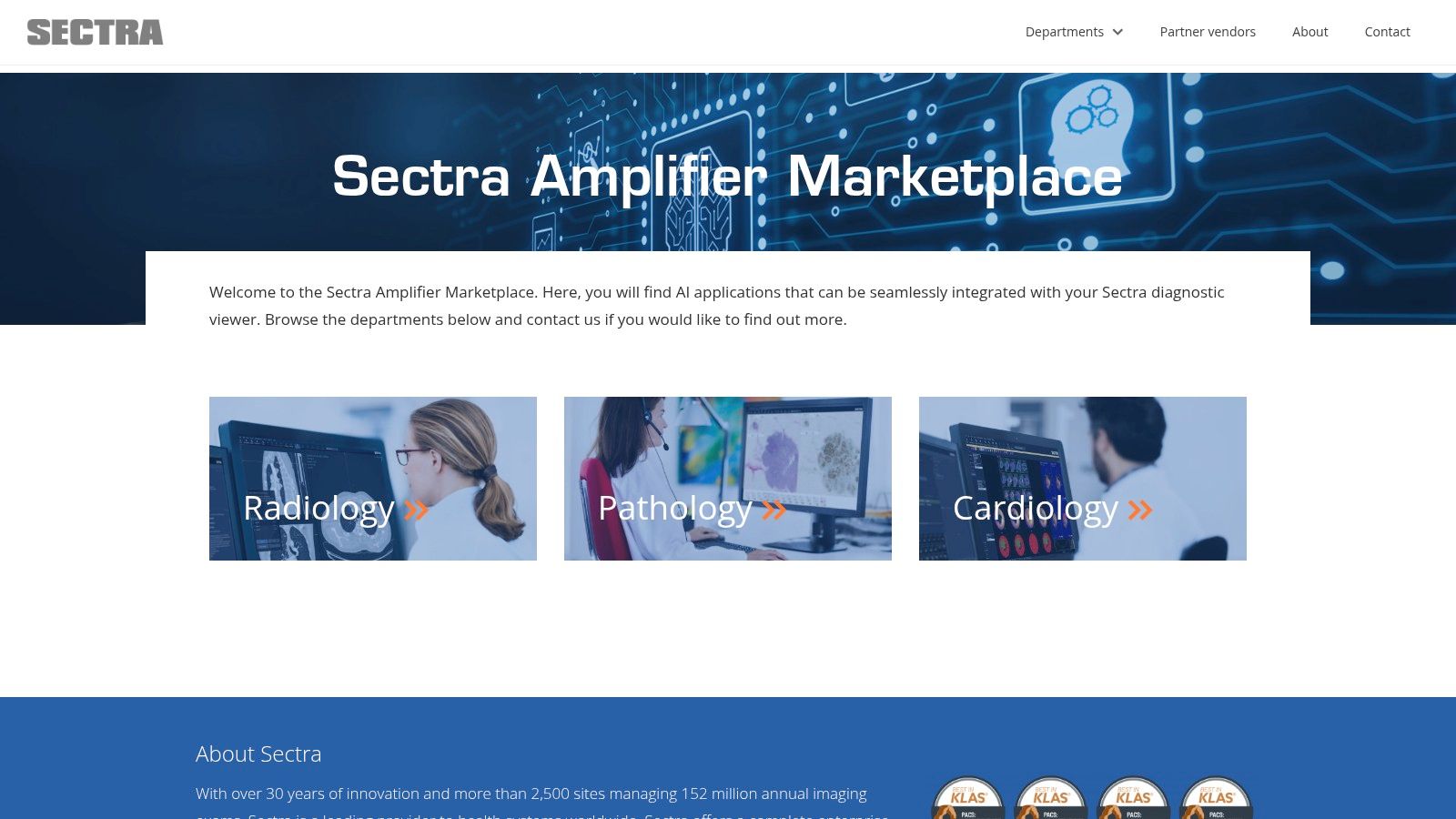
The platform's value lies in its emphasis on regulatory transparency and deep workflow integration. By embedding AI results directly into the Sectra IDS7 diagnostic viewer, it ensures that radiologists and pathologists can leverage AI insights within their native environment. This avoids disruptive workflow changes and simplifies the adoption process for busy clinical teams.
Key Features and Use Cases
The marketplace is designed to streamline the procurement and deployment of specialized imaging AI tools for existing Sectra users.
- Curated and Filterable Catalog: The storefront allows users to filter applications by modality, body part, and regulatory status (e.g., FDA, CE, Health Canada). This helps a cardiology department, for example, quickly find a validated AI tool for cardiac CT analysis that is cleared for use in their region.
- Vendor Due Diligence: Sectra performs a due-diligence process on all listed vendors, ensuring the applications meet technical and clinical standards. This simplifies the evaluation process for hospitals, providing a layer of trust and quality assurance.
- Multi-Vendor Ecosystem: By offering multiple apps for similar use cases, the platform helps organizations avoid vendor lock-in. A health system can compare and choose between several prostate MRI analysis tools, selecting the one that best fits its specific clinical and financial requirements.
Pricing and Implementation
Access to the marketplace is part of the Sectra ecosystem, but pricing for individual AI applications is handled directly with each vendor. This means contracting and payment are decentralized. The platform is exclusively beneficial for organizations already using Sectra’s enterprise imaging solutions, as its primary advantage is the deep integration that guarantees a seamless fit into the existing workflow.
10. Butterfly Network
Butterfly Network democratizes medical imaging by offering a handheld, AI-powered ultrasound probe that connects directly to a smartphone or tablet. Unlike traditional, costly cart-based systems, Butterfly's platform combines hardware (the iQ+ and iQ3 probes) with a sophisticated software and membership model. This positions it as one of the most accessible healthcare AI companies for individual practitioners and smaller clinics, shifting advanced point-of-care ultrasound from a specialized hospital department to a tool that can be carried in a pocket.
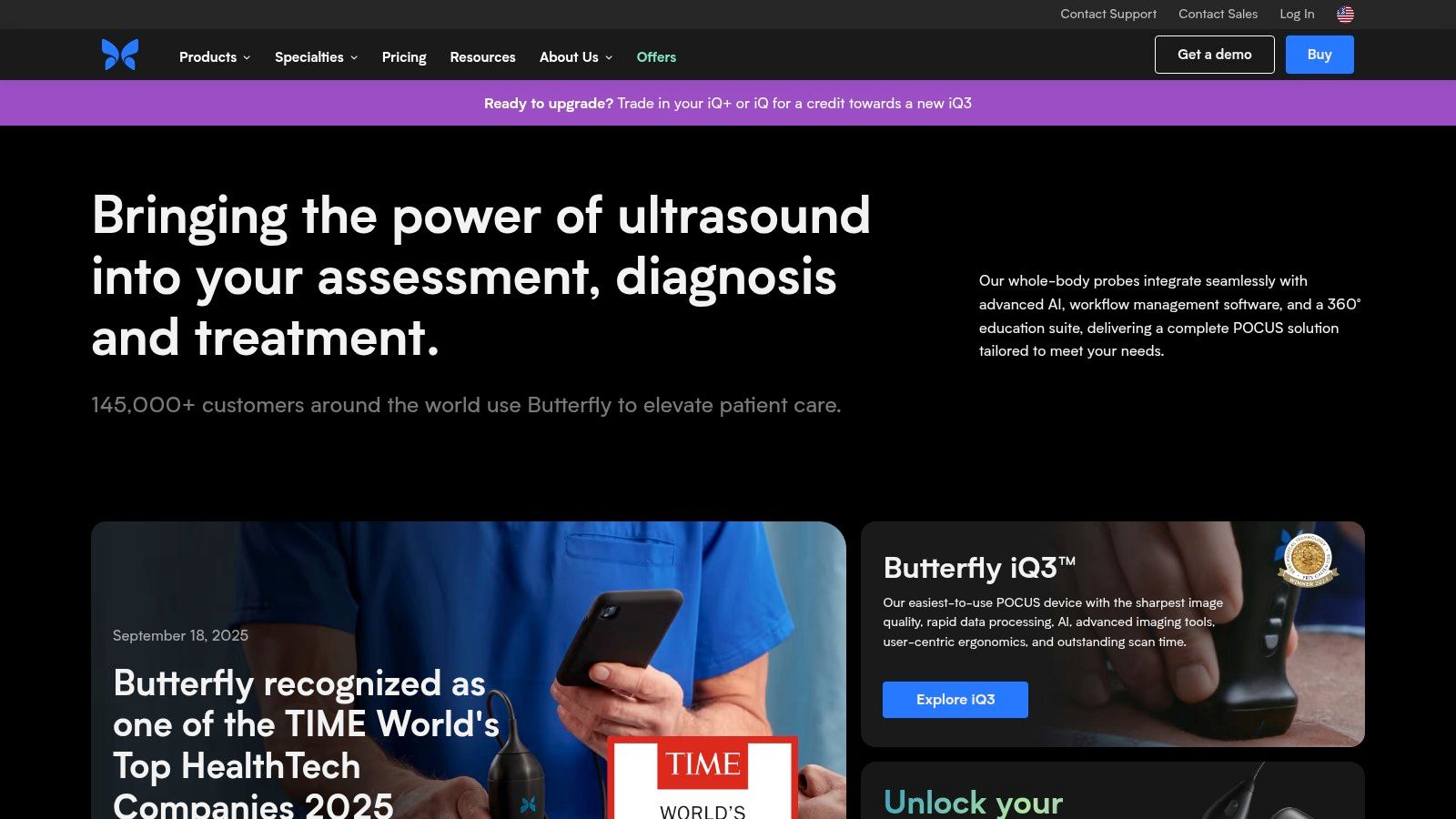
The company’s approach centers on a direct-to-practitioner e-commerce model combined with a cloud-based ecosystem. This provides not just the imaging device but also the software infrastructure for image storage, collaboration, and education. The integration of AI directly into the scanning process helps guide users to capture higher-quality images and interpret findings more efficiently, lowering the barrier to entry for using ultrasound effectively.
Key Features and Use Cases
Butterfly Network's platform is designed for portability and ease of use, making it ideal for rapid diagnostics in various settings, from emergency rooms to remote clinics.
- AI-Powered Guidance: The device includes AI tools like Auto Bladder Volume, which automatically calculates bladder volume, and AI-enabled cardiac guidance tools that help users capture specific views. A common use case is a primary care physician using the iQ3 to quickly assess a patient for fluid in the lungs without needing to refer them for a full chest X-ray.
- TeleGuidance and Education: The platform's app includes TeleGuidance, allowing a remote expert to virtually guide a novice user through a scan in real-time. This is invaluable for training and for providing specialist support in underserved areas.
- Portable App-Based Workflow: All functions are managed through an iOS or Android app, which handles everything from scanning and image capture to cloud storage and sharing. This makes it easy to integrate into fast-paced clinical environments without bulky equipment.
Pricing and Implementation
Butterfly Network operates on a transparent model where the probe is purchased directly from their website, coupled with a required membership subscription. Pricing for the probe is publicly available online in the U.S., with tiered memberships (Pro, Pro Team, and Enterprise) unlocking different features. The base membership is required to scan, while higher tiers add advanced AI tools, more cloud storage, and enterprise-level integrations like DICOM/PACS connectivity. This model is best suited for individual clinicians, small practices, and departments looking for a low-cost entry into point-of-care ultrasound.
11. HeartFlow
HeartFlow provides a non-invasive diagnostic tool that transforms a standard coronary CT angiogram (CCTA) into a detailed, 3D model of a patient's coronary arteries. This AI-powered analysis calculates both fractional flow reserve (FFRct) and characterizes plaque, giving cardiologists crucial physiological data that was previously only available through an invasive procedure. The service operates on a send-out model, fitting seamlessly into existing clinical workflows where CCTA scans are uploaded for remote analysis.
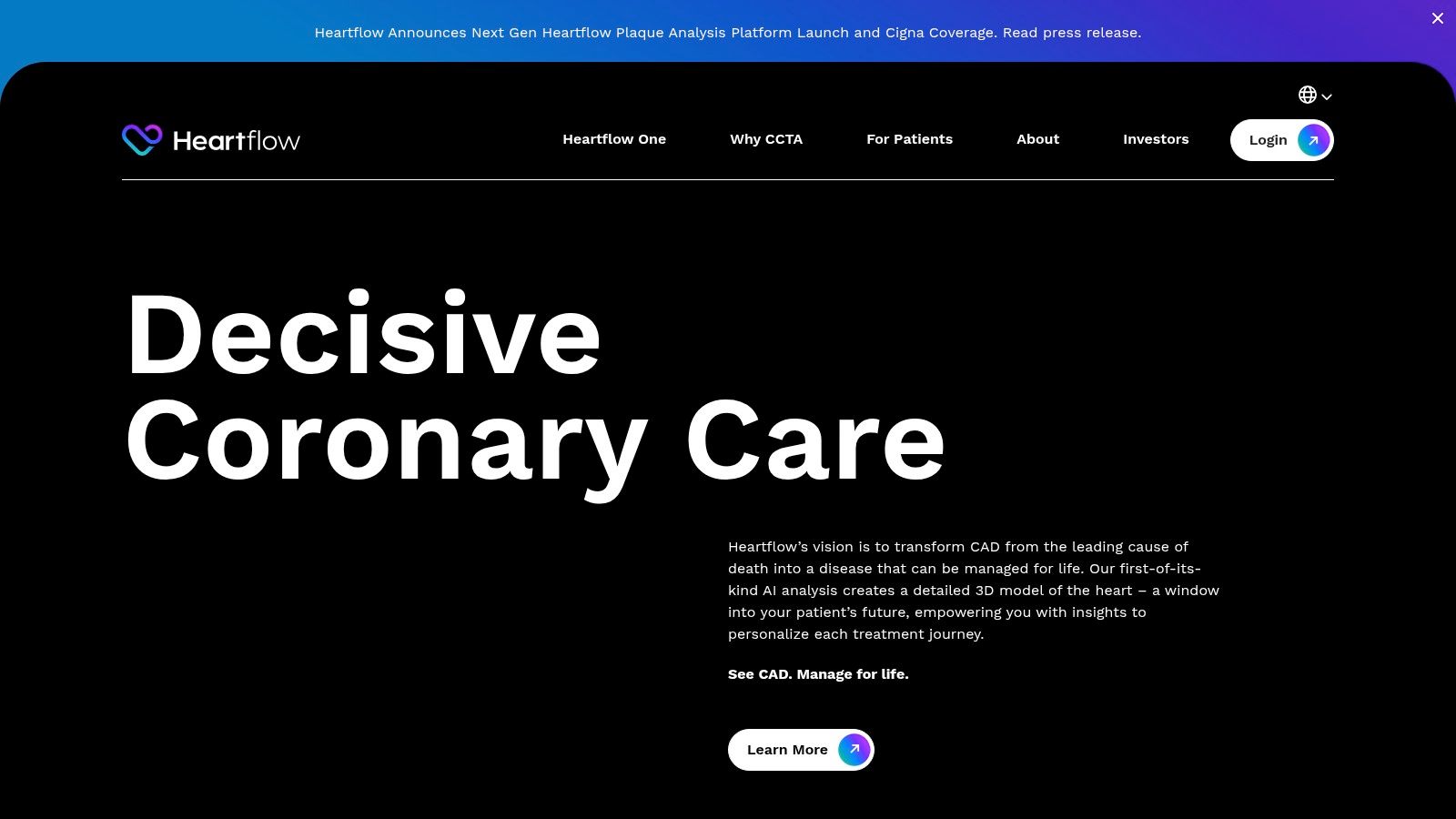
What makes HeartFlow a standout among healthcare AI companies is its success in establishing a clear reimbursement pathway. By securing Category I CPT codes, it has significantly lowered the financial and administrative barriers to adoption for health systems. This focus on economic integration, combined with strong clinical evidence, has made it a practical and widely accepted tool for guiding decisions about invasive coronary interventions.
Key Features and Use Cases
HeartFlow’s analysis is designed to improve diagnostic accuracy and help clinicians create more precise, patient-specific treatment plans for coronary artery disease.
- Non-invasive FFRct Analysis: The core feature provides a physiologic assessment of blood flow limitations from a CCTA scan. A cardiologist can use this to determine if a specific lesion is causing ischemia, helping to avoid unnecessary invasive angiograms and stenting procedures.
- Plaque Analysis and Reporting: Beyond flow dynamics, the service characterizes the volume and type of atherosclerotic plaque. This information is critical for risk stratification and guiding preventive therapies like statin management.
- Established Reimbursement Pathways: HeartFlow offers extensive support for CPT coding and billing, a major advantage for providers. This ensures the service is financially viable and can be integrated sustainably into patient care protocols.
Pricing and Implementation
Pricing is contract-based and determined by volume and specific agreements with healthcare institutions. As a send-out service, implementation primarily involves establishing secure data transfer protocols for CCTA images. The value proposition is strongest for cardiology departments and imaging centers looking to reduce their rates of invasive diagnostic procedures and optimize treatment strategies for patients with suspected coronary artery disease. The quality of the analysis is highly dependent on the quality of the initial CCTA scan.
12. Cleerly
Cleerly shifts the focus of cardiac care from indirect risk factors to the direct analysis of coronary artery disease itself. As one of the more specialized healthcare AI companies, it leverages AI to analyze coronary computed tomography angiography (CCTA) scans, providing a detailed quantification of atherosclerotic plaque. This approach moves beyond traditional stenosis assessment to characterize plaque burden, composition, and type, offering a more precise picture of a patient's heart attack risk.
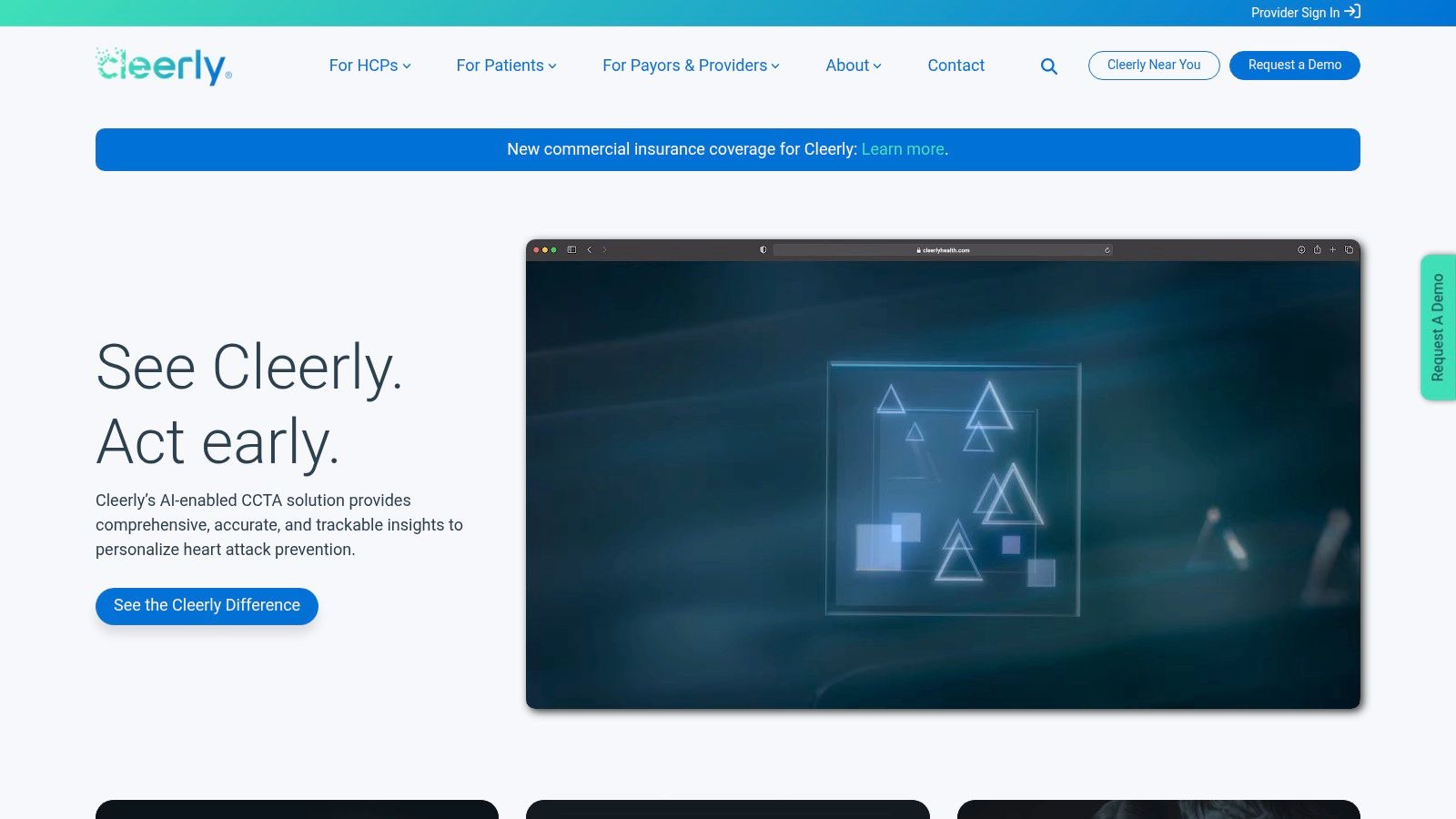
The platform translates complex imaging data into actionable, personalized reports for clinicians and patients. By phenotyping plaque, Cleerly helps physicians tailor preventive treatment strategies long before a major cardiac event occurs, fundamentally changing the paradigm from reactive to proactive cardiovascular care. This makes it a crucial tool for cardiologists and primary care physicians focused on prevention.
Key Features and Use Cases
Cleerly’s AI-driven analysis provides insights that traditional diagnostic methods often miss, enabling early and targeted intervention.
- Detailed Plaque Phenotyping: The platform quantifies the exact amount and type (e.g., low-density, non-calcified) of plaque. A key use case is for a patient with a normal stress test but significant non-obstructive, high-risk plaque, allowing a physician to initiate aggressive lipid-lowering therapy that would have otherwise been missed.
- Quantitative Stenosis and Ischemia Workflows: It provides precise, AI-measured stenosis data and correlates findings with the likelihood of ischemia. This helps clinicians make more informed decisions about whether to pursue further invasive testing like a cardiac catheterization.
- Longitudinal Tracking: The system allows for serial CCTA scan comparisons to monitor plaque progression or regression over time in response to treatment. This provides objective evidence of therapy effectiveness.
Pricing and Implementation
Cleerly's services are available to providers and are increasingly offered directly to consumers through a growing network of partner clinics with transparent cash-pay options. Insurance coverage can be variable, which is a key implementation consideration for health systems. Successful deployment requires access to high-quality CCTA imaging capabilities and establishing clinical workflows to act on the detailed reports, making it best suited for cardiology practices and health systems prioritizing cardiovascular disease prevention programs.
Top 12 Healthcare AI Companies — Feature Comparison
| Product | Primary use case | Core features | Target audience | Value / Pricing & Deployment |
|---|---|---|---|---|
| Aidoc | Imaging AI orchestration & governance | aiOS orchestration; PACS/EHR/mobile integration; drift & performance analytics | Large health systems, radiology departments | Enterprise scaling & governance; quote‑based pricing; best for high imaging volume |
| Viz.ai | AI detection + care coordination | 50+ FDA‑cleared algorithms; automated CT/echo/EKG detection; real‑time mobile alerts & collaboration | Hospitals with acute/on‑call teams (stroke, cardiac) | Shortens time‑to‑treatment; quote‑based; needs imaging & EHR integration |
| Abridge | Ambient clinical documentation | Real‑time note generation; Epic integrations; specialty tuning (>100 specialties) | ED clinicians, nurses, Epic‑using health systems | Saves clinician time; enterprise contracts; EHR vendor dynamics may change |
| Nuance Dragon Medical One (Microsoft) | Clinical speech recognition & dictation | Per‑seat subscription; PowerMic Mobile; EHR workflow compatibility | Clinicians needing dictation; small to large practices | Transparent US pricing for small bundles; Windows‑only; setup service fee |
| Epic Showroom (Open Epic / Connection Hub) | Marketplace for Epic integrations | Vendor listings with integration details; FHIR emphasis; certified paths | Epic‑using health systems, IT/procurement teams | Streamlines discovery/integration; vendor quote pricing; access limited to Epic customers |
| AWS Marketplace – Healthcare AI solutions | Procurement & deployment on AWS | SaaS/AMIs/K8s listings; private offers; consolidated billing | AWS‑centric enterprises, procurement & cloud teams | Flexible commercial terms; requires AWS tenancy & ops capability |
| Google Cloud Marketplace – Healthcare & Life Sciences | Catalog for GCP‑deployable AI | Vertex AI support; private marketplace; governance in Cloud Console | Google Cloud customers, enterprise buyers | Streamlined contracting for GCP users; requires GCP tenancy & ops |
| Microsoft Azure / Marketplace – Healthcare AI | Marketplace for Azure‑deployable healthcare AI | Azure integration; HIPAA‑aligned listings; private offers & trials | Azure‑centric health systems & IT teams | Familiar procurement for Microsoft shops; needs Azure tenancy; variable deployment |
| Sectra Amplifier Marketplace | Curated imaging AI marketplace for Sectra | Filter by modality & regulatory status; vendor due‑diligence; multiple apps per use case | Radiology/cardiology/pathology teams on Sectra | Regulatory transparency & workflow fit; best for Sectra customers; vendor contracts |
| Butterfly Network | Handheld AI‑enhanced ultrasound platform | Membership tiers; TeleGuidance; mobile app + cloud storage; AI imaging modes | Point‑of‑care clinicians, outpatient & field teams | Transparent e‑commerce; membership required for advanced features; enterprise add‑ons |
| HeartFlow | Send‑out coronary CTA FFRCT analysis | Noninvasive FFRCT; plaque analysis & reporting; CPT reimbursement guidance | Cardiology/imaging centers, referring physicians | Proven impact on care decisions; established payer coverage; contract pricing |
| Cleerly | Coronary plaque quantification & phenotyping | Quantitative plaque composition; stenosis metrics; ischemia likelihood workflows | Cardiology clinics, prevention programs, imaging centers | Actionable plaque phenotyping; insurance coverage varies; often cash‑pay options through clinics |
Choosing Your Partner: From Strategy to Scalable Impact
The landscape of healthcare AI companies is no longer a futuristic concept; it's a present-day reality delivering tangible value across the care continuum. From the lightning-fast triage capabilities of Viz.ai and Aidoc in critical care to the administrative relief provided by Abridge and Nuance Dragon Medical One, the solutions we've explored demonstrate a clear shift. AI is moving from a novel technology to an indispensable clinical and operational asset.
We've seen how specialized tools like Butterfly Network, HeartFlow, and Cleerly are revolutionizing diagnostics in cardiology and point-of-care imaging. Simultaneously, major cloud marketplaces from AWS, Google Cloud, and Microsoft Azure, along with specialized platforms like Sectra Amplifier, are democratizing access to a diverse ecosystem of AI applications. The overarching theme is clear: these are not just tools, but strategic enablers that augment human expertise, streamline complex workflows, and ultimately elevate the standard of patient care. The challenge is no longer finding AI solutions, but intelligently selecting and integrating the right ones.
Synthesizing Your AI Strategy: From Needs to ROI
Selecting the right partner from the diverse list of healthcare AI companies is a critical strategic decision, not merely a procurement exercise. Your choice will reverberate through clinical workflows, data infrastructure, and your organization's financial health. To navigate this complexity, start by internalizing your specific needs rather than getting distracted by impressive but irrelevant features.
A radiology department aiming to reduce report turnaround times has fundamentally different requirements than a primary care network looking to decrease physician burnout from documentation. The former might prioritize Aidoc for its comprehensive suite of diagnostic algorithms, while the latter would find more immediate value in Abridge's ambient listening technology.
Consider these core pillars before engaging with any vendor:
- Clinical Validation: Does the company have robust, peer-reviewed evidence supporting its claims? Look for studies that demonstrate improved patient outcomes or significant efficiency gains in real-world clinical settings.
- Workflow Integration: How seamlessly does the solution integrate with your existing EMR (like Epic), PACS, or other critical systems? A powerful algorithm is useless if it creates friction for clinicians.
- Scalability and Support: Can the solution scale across your enterprise? What level of technical and clinical support does the vendor provide during and after implementation? This is crucial for long-term success.
Implementation: The Bridge Between Technology and Transformation
The journey from selecting a vendor to achieving measurable impact is paved with careful implementation. Even the most advanced AI tool will fail if it's not adopted effectively by the frontline staff who use it daily. A successful rollout requires a multi-faceted approach that goes beyond technical setup.
- Define Success Metrics Upfront: Before you deploy, establish clear, measurable Key Performance Indicators (KPIs). For a tool like Viz.ai, this could be a reduction in door-to-needle time for stroke patients. For Nuance, it might be a decrease in EMR documentation time per patient encounter.
- Champion Clinical Buy-In: Identify clinical champions who understand the value of the AI tool and can advocate for its use among their peers. Their involvement from the beginning is essential for overcoming skepticism and driving adoption.
- Plan for Data Governance and Security: Integrating any new AI solution introduces new data pathways. Ensure the vendor meets all HIPAA compliance standards and that you have a clear governance strategy for the data the AI processes and generates.
Ultimately, the most successful healthcare AI companies are those that function as true partners, working alongside your organization to solve core challenges. The goal isn't just to implement software; it's to create a sustainable, scalable AI-powered ecosystem that continuously improves efficiency, empowers clinicians, and delivers superior patient care. This strategic alignment is the true hallmark of a transformative partnership.
Navigating the crowded market of healthcare AI companies to find the perfect fit for your specific challenges can be overwhelming. Ekipa AI helps you cut through the noise by rapidly identifying and validating high-impact AI opportunities within your organization. Our platform connects your strategic needs to the right technology partners, ensuring your AI initiatives deliver measurable results from day one. Learn more at Ekipa AI.

